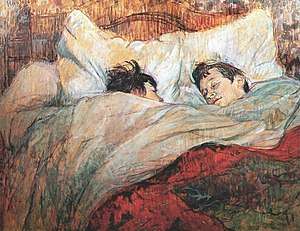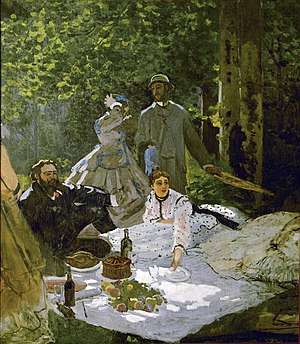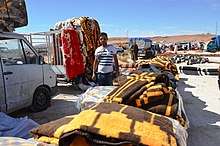Blanket
A blanket is a piece of soft cloth large enough either to cover or to enfold a great portion of the user's body. They are usually used when a person goes to sleep or is otherwise at rest. They trap radiant bodily heat that otherwise would be lost through convection, helping to keep the skeleton warm. Many children and some adults utilize a blanket as a comfort object.

Etymology
The term arose from the generalization of a specific fabric called Blanket fabric, a heavily napped woolen weave pioneered by Thomas Blanket (Blanquette), a Flemish weaver who lived in Bristol, England, in the 14th century.[1][2] Earlier usage of the term is possible through its derivation from the French word for white, blanc.[3][4]
Types


Many types of blanket material, such as wool, are used because they are thicker and have more substantial fabric to them, but cotton can also be used for light blankets. Wool blankets are warmer and also relatively slow to burn compared to cotton. The most common types of blankets are woven acrylic, knitted polyester, mink, cotton, fleece and wool. Blankets also come with exotic crafting and exotic material such as crocheted afghan or a silk covering. The term blanket is often interchanged with comforter, quilt, and duvet, as they all have similar uses.
Uses
Blankets have been used by militaries for many centuries.[5] Militaries are some of the biggest single consumers of woolen blankets. Military blankets tend to be coarse grey, with thick fibers of over 20 microns. Suppliers include J. E. Ashworth & Sons and Faribault Woolen Mills, who made half of all blankets in America at one time.
Special blankets known as baby blankets are used to protect infants from the cold. Small children (and some adults) may also use a blanket as a comfort object.[6]
Blankets may be spread on the ground for a picnic or where people want to sit in a grassy or muddy area without soiling their clothing. Temporary blankets have been designed for this purpose.
See also
References
- "Origin of Blanket". The New York Times. 24 March 1901.
- "Factors in the Development of the Cotswold Woollen Industry". 90: 349–362. JSTOR 1787694. Cite journal requires
|journal=(help) - "blanket". Podictionary. Retrieved 21 August 2012.
- "Online Etymology Dictionary: blanket". Etymonline.com. Retrieved 21 August 2012.
- Palmer, Alexandra (2004). Fashion: A Canadian Perspective. University of Toronto Press. ISBN 9780802085900.
- Gerritzen, Mieke; Lovink, Geert; Kampman, Minke (2011). I Read where I Am: Exploring New Information Cultures. Graphic Design Museum. ISBN 9789078088554.
External links
![]()
![]()